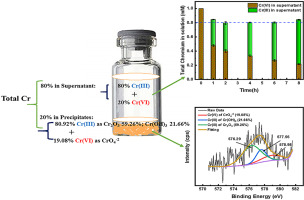当前位置:
X-MOL 学术
›
Chemosphere
›
论文详情
Our official English website, www.x-mol.net, welcomes your feedback! (Note: you will need to create a separate account there.)
Iron mineral-humic acid complex enhanced Cr(VI) reduction by Shewanella oneidensis MR-1.
Chemosphere ( IF 8.8 ) Pub Date : 2020-01-11 , DOI: 10.1016/j.chemosphere.2020.125902 Abdelkader Mohamed 1 , Lu Yu 2 , Yu Fang 2 , Noha Ashry 2 , Yassine Riahi 2 , Intisar Uddin 2 , Ke Dai 2 , Qiaoyun Huang 2
Chemosphere ( IF 8.8 ) Pub Date : 2020-01-11 , DOI: 10.1016/j.chemosphere.2020.125902 Abdelkader Mohamed 1 , Lu Yu 2 , Yu Fang 2 , Noha Ashry 2 , Yassine Riahi 2 , Intisar Uddin 2 , Ke Dai 2 , Qiaoyun Huang 2
Affiliation

|
Microorganisms, iron minerals, and humic acid are widely common in the soil and water environment and closely interact within environmental processes. In this study, the Cr(VI) removal by Shewanella oneidensis MR-1 (S. oneidensis) was examined in the presence of goethite and humic acid (HA) to mimic the real environment situation. Scanning electron microscopy (SEM) combined with energy disperse spectroscopy (EDS), X-ray photoelectron spectroscopy (XPS), and electron paramagnetic resonance (EPR) technologies were used to probe the Cr(VI) reduction mechanism. Our results showed that S. oneidensis alone could reduce 65% of 1.0 mM Cr(VI) after 8 h of the reduction process. Meanwhile, Cr(VI) reduction rate was declined to 56% in the presence of goethite or humic acid. Contrary, the Cr(VI) reduction rate was mightily increased to 79% by the ternary complex of S. oneidensis-goethite-HA where reduced humic acid (HAred) acted as electron shuttles and diminished the bacterial adhesion to the goethite surface thereby enhanced electron transfer and increased the extent of Cr(VI) reduction by 1.3 fold. XPS analysis indicated that Cr(VI) was reduced to Cr(III), and the final yields were Cr(OH)3 and Cr2O3 precipitated on the surface of bacterial cells. S. oneidensis could also reduce Fe(III) in goethite to Fe(II), which in turn reduced Cr(VI). These results suggested that iron mineral-humic acid complex could enhance the microbial reduction of Cr(VI) and revealed the promotion role of HA in the Cr(VI) bioreduction process. This study affords inclusive insights on the Cr(VI) reduction kinetics and mechanisms in the most complicated systems.
中文翻译:

铁矿物-腐殖酸络合物可提高沙瓦氏菌(Shewanella oneidensis)MR-1对Cr(VI)的还原作用。
微生物,铁矿物质和腐殖酸在土壤和水环境中普遍存在,并在环境过程中密切相互作用。在这项研究中,在针铁矿和腐殖酸(HA)的存在下检测了Shewanella oneidensis MR-1(S. oneidensis)对Cr(VI)的去除,以模拟实际环境。扫描电子显微镜(SEM)结合了能量分散光谱(EDS),X射线光电子能谱(XPS)和电子顺磁共振(EPR)技术来探测Cr(VI)的还原机理。我们的结果表明,在还原过程8小时后,单独的拟南芥可以还原1.0 mM Cr(VI)的65%。同时,在针铁矿或腐植酸存在下,Cr(VI)的还原率降至56%。相反,S.oneidensis-goethite-HA的三元络合物将Cr(VI)的还原率大大提高至79%,其中还原的腐殖酸(HAred)充当电子穿梭,并减少了细菌与针铁矿表面的粘附,从而增强了电子传递和Cr(VI)还原程度增加了1.3倍。XPS分析表明Cr(VI)被还原为Cr(III),最终产量为Cr(OH)3和Cr2O3沉淀在细菌细胞表面。S.oneidensis还可以将针铁矿中的Fe(III)还原为Fe(II),从而还原Cr(VI)。这些结果表明,铁矿物-腐殖酸复合物可以增强Cr(VI)的微生物还原,并揭示HA在Cr(VI)生物还原过程中的促进作用。
更新日期:2020-01-13
中文翻译:

铁矿物-腐殖酸络合物可提高沙瓦氏菌(Shewanella oneidensis)MR-1对Cr(VI)的还原作用。
微生物,铁矿物质和腐殖酸在土壤和水环境中普遍存在,并在环境过程中密切相互作用。在这项研究中,在针铁矿和腐殖酸(HA)的存在下检测了Shewanella oneidensis MR-1(S. oneidensis)对Cr(VI)的去除,以模拟实际环境。扫描电子显微镜(SEM)结合了能量分散光谱(EDS),X射线光电子能谱(XPS)和电子顺磁共振(EPR)技术来探测Cr(VI)的还原机理。我们的结果表明,在还原过程8小时后,单独的拟南芥可以还原1.0 mM Cr(VI)的65%。同时,在针铁矿或腐植酸存在下,Cr(VI)的还原率降至56%。相反,S.oneidensis-goethite-HA的三元络合物将Cr(VI)的还原率大大提高至79%,其中还原的腐殖酸(HAred)充当电子穿梭,并减少了细菌与针铁矿表面的粘附,从而增强了电子传递和Cr(VI)还原程度增加了1.3倍。XPS分析表明Cr(VI)被还原为Cr(III),最终产量为Cr(OH)3和Cr2O3沉淀在细菌细胞表面。S.oneidensis还可以将针铁矿中的Fe(III)还原为Fe(II),从而还原Cr(VI)。这些结果表明,铁矿物-腐殖酸复合物可以增强Cr(VI)的微生物还原,并揭示HA在Cr(VI)生物还原过程中的促进作用。



























 京公网安备 11010802027423号
京公网安备 11010802027423号